Today, we're going to look at one of our favorite exercises for building a big, massive pec: the inclined fly . This exercise is also known as the incline bench dumbbell fly . Know all the secrets of movement.
Normally, the incline dumbbell fly should not be a main exercise in your chest workout. This exercise should be secondary or accessory. A chest routine would not begin with a dumbbell fly, but rather a barbell or dumbbell bench press, unless pre-exhaustion is being sought with a specific goal.
What muscles do the incline bench flyes work?
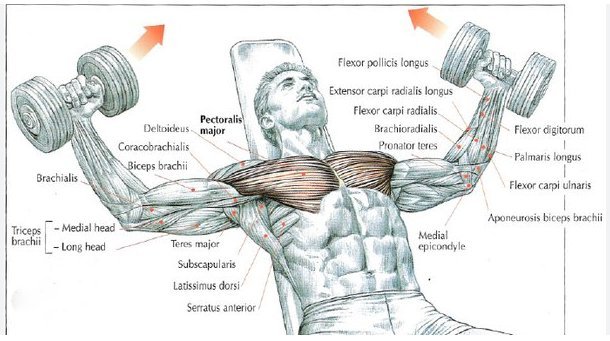
This is an isolation exercise that targets the muscles of the upper chest . Activate the upper pectoral muscles, which are difficult to develop with a flat bench. Studies have shown that dumbbell flyes provide greater activation of the biceps brachii muscle . For most athletes, combining the inclined and flat starts gives the best results.
What material do I need to do inclined flyes?
You will require dumbbells with an adequate weight and an adjustable weight bench. Beginner and intermediate users can do this exercise with no problem. Let's see the correct technique.
How to do incline dumbbell flyes
First of all, we have to talk about the inclination of the bank. The exercise can be done with various inclinations. Adjust the incline from 15 to 45 degrees (typically, this is 2-3 steps on the bench). The more incline the bench has, the more difficult the exercise will be and the more work it will take to lift the weight. We recommend playing with the inclinations. You can train for a season with the bench inclined at 30º. Later, you can lower the incline to 15º to use more weight in the exercise. It is also possible to change the incline from one series to another. For example, you could do a heavy set with a 30º incline, and another set with lighter dumbbells using a 15º incline. Use all the resources available to progress in this exercise and give a good stimulus to the pectoral.
When you have set the desired incline on the bench, you will need to get the technique right .
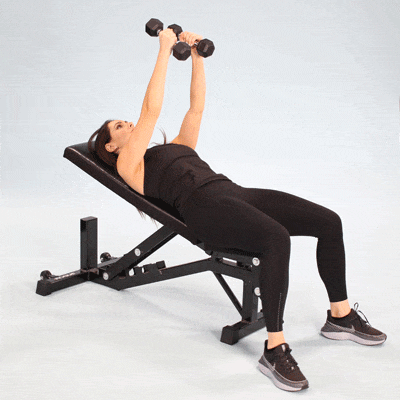
1. How to position yourself in the bank :
Sit on the incline bench with both feet on the ground. Lie down and bring the weights above your chest. Elbows should be slightly bent with palms facing each other (imagine you are hugging a barrel to your chest. This is the starting position.
How to raise heavy dumbbells? If you're going to use heavy dumbbells, you'll need to drive them together and up over your chest when you lie down on the bench. If the dumbbells are light, you can hold them firmly against your chest as you position yourself on the bench.
2. Lower the dumbbells
Inhale and slowly lower the dumbbells in an arc with your arms until you feel a slight stretch in your chest or shoulders.
3. Raise the dumbbells
Exhale and return the dumbbells to the starting position, keeping the arms arched throughout the movement.
When you are finished doing the exercise, return the dumbbells to the center of your torso. Depending on the weight you used, place the dumbbells on your chest or on your thighs as you exhale and use your abdomen to lift yourself up.
Very important : Never completely straighten your arms when lowering the dumbbells when doing this exercise. That is dangerous and could injure you. Try to maintain a slight flexion of the elbows at all times.
Fill your ribcage well with air before lowering the dumbbells to apply maximum force. The depth to which you can go down depends on the flexibility of each person. The exercise will be effective when you notice a slight pull in the chest.
How to use heavy dumbbells in incline fly?
First of all, we must emphasize that the inclined fly is not an exercise designed to lift a lot of weight. It is an isolation movement to stretch the fibers of the upper pectoral. Also, using too much weight for this exercise could injure your shoulders and elbows. Do not use very heavy dumbbells if you are a beginner.
However, more advanced users will want to take advantage of the benefits of lifting more weight to gain strength in this exercise. There is indeed a way to do the incline fly with heavy dumbbells while minimizing the risk of injury (which will always exist). To do this, you have to bend your elbows a little more when lowering the dumbbells. You can position your elbows so that your upper arm and forearm form a 90º angle. When you feel the stretch in your chest, raise your arms to return the dumbbells to the starting position. Placing your elbows this way will prevent weight from beating your arm during the descent. You have to control the weight very well and be very careful while doing this technique.
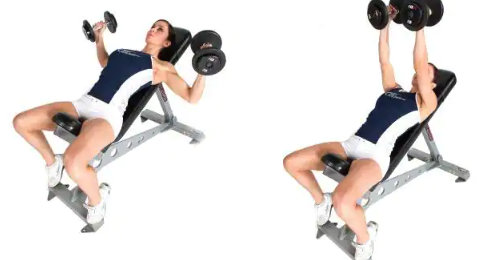 |
| Do your heavy dumbbell fly by bending your elbows like this. |
This move is a hybrid between the chest fly and the dumbbell bench press. Is it beneficial to do heavy inclined flyes? Yes, especially when you are an advanced athlete in bodybuilding.
- • Using heavy dumbbells for sets of 10, 8, or 6 reps at high intensity recruits more fibers and allows you to gain more strength.
- • Using heavy weights in the fly from time to time allows you to loosen up and improve your technique and strength on the lighter sets. In other words, if you get used to doing some heavy sets, you will improve your performance when you pick up lighter weights again.
| Professional bodybuilder doing heavy dumbbell flyes. |
Don't focus your training exclusively on heavy sets. As we said, this exercise works best with light to medium weights moved at 15-20 repetitions. Use the heavy inclined flyes occasionally and only for a few sets. You will see that this technique will help you move the weights you used before in a more fluid way.
Frequent mistakes when doing overhead fly with dumbbells
Avoid common mistakes to safely perform the Incline Chest Fly exercise and maximize its effectiveness.
Having little control over exercise
You have to control the movement from start to finish to perform the exercise slowly and with concentration. One sign that you may not have enough movement control is the dumbbells coming together above your chest. At the end of a repetition, you should bring the dumbbells closer, but not let them collide with each other. If this happens, slow down and practice better control over the movement.
Cause excessive thoracic extension
Extending and lowering the dumbbells too much puts you at risk of injury. Your goal is to use as comfortable a range of motion as your body allows so that the exercise can be done safely.
Lifting too much weight
Lifting too heavy a load puts you at risk of injuring your shoulder or other muscles. Start with lighter dumbbells to perform the exercise with good form. As you get stronger, you can increase the weight you lift.
Excessive bending of the elbows
Excessive elbow flexion limits the range of motion of the exercise and reduces efficiency. Keep your elbows slightly bent throughout the movement. This will prevent unnecessary shoulder strain and ensure correct form and technique. This, unless you are advanced and are putting into practice the technique to lift heavier that we explained to you.
Dumbbell Incline Bench Fly Variations
You can do the incline dumbbell fly in different ways depending on your level of fitness.
Inclined flyes for beginners
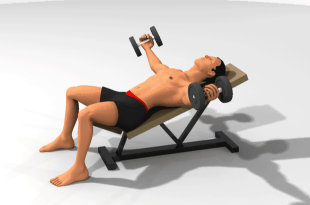 |
| Flyes with dumbbells on a bench without too much inclination. |
If you're new to the incline bench fly , you may need to make a few changes to make the exercise easier. For example, you could reduce the incline of the bench . Use only the first incline point of the bench (which will be about 15º on most weight benches). You can also start by doing the dumbbell fly (with the bench completely straight, without any incline). Try using light weights until you feel more confident with the movement.
Inclined flyes with pulley
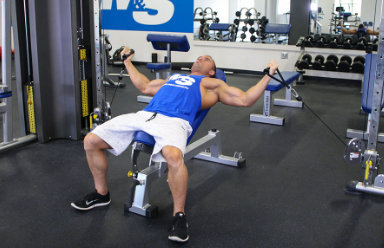
Try doing incline flyes from time to time instead of using dumbbells. Your upper and stabilizing muscles will have to work harder to keep the resistance constant throughout the movement.
To do this exercise, you'll need a pulley ("crossover") station like the ones found at most gyms. Place the adjustable bench in the center of the cable station. You will need to do the incline fly on the low pulley . Attach the individual handles to the low pulleys (one on each), pull the cables toward you, and lie down on the incline bench.
The movement is the same as with the dumbbells. However, you will see that the exercise will cost you much more because it is difficult to stabilize the cables. It is a different way of giving stimulation to the muscle.
Inclined pectoral fly with palms facing down
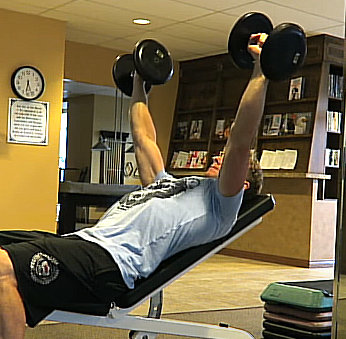
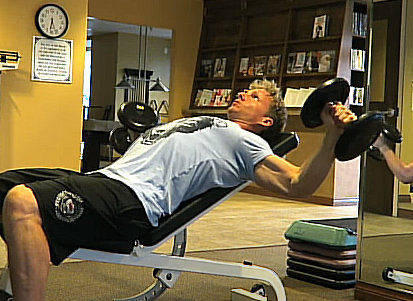
Performing the exercise with your palms facing down, rather than palms facing each other, affects the muscle fibers in a different way and may feel more difficult. Keep in mind that this variation puts extra pressure on the shoulders and may not be suitable for people with shoulder injuries.
Inclined flyes machine
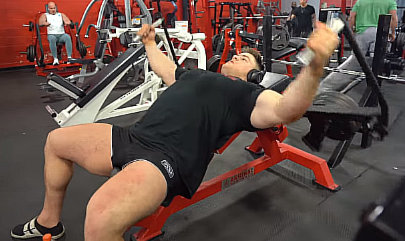
Some gyms and sports centers have this fantastic machine. Many professional bodybuilders experience a good feeling doing the exercise here. The machine can be loaded with plates or built into a tower with weight plates. You should be lucky to find a gym that has the incline fly machine. In any case, we will always advise free weights over machines. Machine exercise should always be secondary.
Benefits of flyes for the upper chest
Dumbbell flys target the upper chest and are a great way to improve pectoral development. In this movement, the shoulders play a secondary role, while the triceps stabilize the movement.
• The flat dumbbell fly benefits the pectoralis major muscle, but the incline fly goes a step further and isolates the upper part of this muscle. Using both exercises in a training program helps maximize chest training.
• If your upper body routine includes push-ups, this exercise can make them easier to perform because it requires the same muscles and stabilizers.
• The incline dumbbell fly also stretches the pectoral muscles and stimulates scapular contraction by squeezing the shoulder blades into the back. This helps improve posture. It can also make everyday activities easier, like lifting a heavy object off a high shelf.
Do I flyes on an incline or on a flat bench?
Quite a few beginners ask themselves "should I do the sloping or flat flyes? ". It is advisable that you do both exercises as accessories. You can do both in the same training session. You can also alternate them by seasons. For example, spending a couple of months doing flyes on the flat bench and then another two months performing flyes on the incline bench.
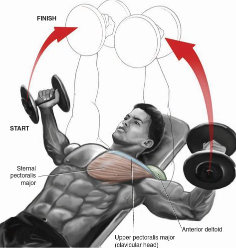
Our advice is to make progressions of weights and repetitions, and to change the angles of the bench from time to time. Try the bench flat and with inclines of 15º, 30º and 45º. In this way, you will be able to work the pectoral from various positions. The choice of the flyes with flat or inclined dumbbells will also depend on the points to improve in the person's physique. Athletes with difficulty developing the upper pecs will want to include more incline fly work.
If you have a chest or shoulder injury, consult a doctor or physical therapist before doing the fly. If you feel pain or discomfort during a movement (that doesn't feel fluid), stop the exercise.
When you first start out, try to do a set of 12 to 15 repetitions. As your chest strength begins to improve, increase the reps, then do more sets. You can train series of 10 and even 30 repetitions.
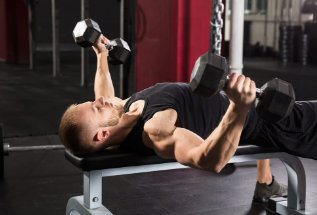
How to incorporate upper flyes into a pectoral workout? One way is to put them as a second or third exercise. As an example, flat bench press and then flyes; or flat bench press, dips on the bars, and then flyes. You can do 3 sets of flyes. Start with light weights that allow you to do 30 repetitions. As the weeks go by, work your way up to larger dumbbells until you reach weights that only allow you to do about 8 reps. Then, go back to light weights and start the progression again by trying to beat your personal rep records.
You can also incorporate incline bench flyes at the end of your chest workout. In this case, you will not be looking for a progression of strength, but rather pump the pec and get a total pump. Work with a light weight that allows you to do 15 to 30 repetitions. Perform a couple of sets to finish your workout.
Preexhaustion: Other people perform flyes before a basic exercise like the barbell bench press. In this case, it is a question of maximizing the work of this basic exercise having the pectoral pre-exhausted. Training with the pre-exhausted muscle also serves to improve strength in the basic exercise. For example, you can do a couple sets of dumbbell flyes before your pressing exercises.
Generally add incline flyes to your workout to maximize your pectoral pump and strength. For us, this exercise is a must. The movement requires technique, but you will learn it quickly if you follow our instructions.









